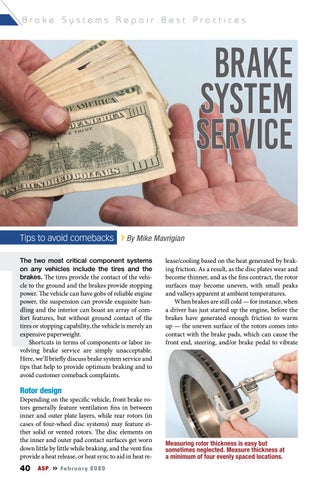Brake Systems Repair Best Practices
Brake system service
T
Tips to avoid comebacks
By Mike Mavrigian
The two most critical component systems on any vehicles include the tires and the brakes. The tires provide the contact of the vehicle to the ground and the brakes provide stopping power. The vehicle can have gobs of reliable engine power, the suspension can provide exquisite handling and the interior can boast an array of comfort features, but without ground contact of the tires or stopping capability, the vehicle is merely an expensive paperweight. Shortcuts in terms of components or labor involving brake service are simply unacceptable. Here, we’ll briefly discuss brake system service and tips that help to provide optimum braking and to avoid customer comeback complaints.
lease/cooling based on the heat generated by braking friction. As a result, as the disc plates wear and become thinner, and as the fins contract, the rotor surfaces may become uneven, with small peaks and valleys apparent at ambient temperatures. When brakes are still cold — for instance, when a driver has just started up the engine, before the brakes have generated enough friction to warm up — the uneven surface of the rotors comes into contact with the brake pads, which can cause the front end, steering, and/or brake pedal to vibrate
Rotor design
Depending on the specific vehicle, front brake rotors generally feature ventilation fins in between inner and outer plate layers, while rear rotors (in cases of four-wheel disc systems) may feature either solid or vented rotors. The disc elements on the inner and outer pad contact surfaces get worn down little by little while braking, and the vent fins provide a heat release, or heat sync to aid in heat re-
40
ASP
Februa ry 20 20
Measuring rotor thickness is easy but sometimes neglected. Measure thickness at a minimum of four evenly spaced locations.




